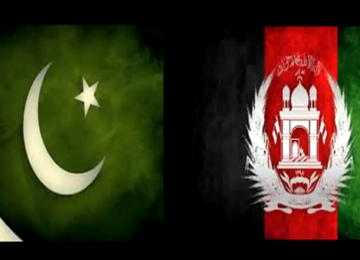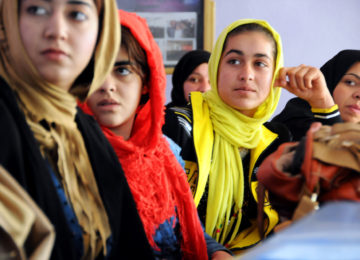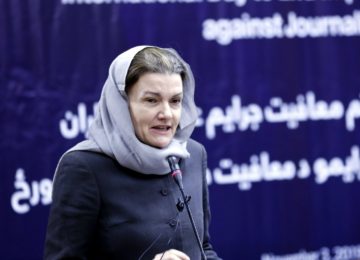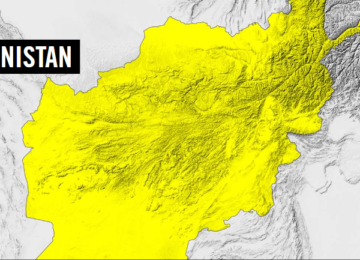Almost a week on since I wrote on the (im)probability of peace talks with the Taliban, Afghanistan has not only seethed with violence but has further drifted into the abyss of terror. The country’s misery has continued in 2018 as a spate of major terror attacks, especially in the heavily-guarded capital of Kabul, has left its people reeling with agony, terror and fear.
In the latest of these attacks, 11 soldiers were killed when five Islamic State (IS) militants attacked the Marshal Fahim National Defense University (MFNDU) on January 29th. This was the third major attack in just over a week, with the other two including an attack on the Intercontinental Hotel, killing over 40 people, and an ambulance attack which killed over a hundred people, on January 20th and 27threspectively.
To make matters worse, both the Taliban and the Donald Trump administration have shown no signs of flexibility. With the US president closing doors on reconciliation efforts, and the Taliban saying ‘they never wanted to hold any peace talks with the US’ in the first place, there seems no sign of compromise. The Afghan government, too, feels that the only way now to achieve peace in the country is through total defeat of the Taliban.
For the Afghan people, there simply seems no light at the end of the tunnel. Where the Taliban had previously claimed to have only attacked non-civilian targets, it seems as if the group is now competing with the IS to kill maximum number of civilians. Moreover, with the coalition troops merely confined to their bases in Kabul, the country might soon become a battlefield for both militant groups vying for maximum territorial control.
The situation has become so dire that John Sopko, the Special Inspector General for Afghanistan Reconstruction (SIGAR), was, for the first time, asked by the Pentagon not to release figures of the IS and Taliban’s territorial control in the country. In his letter attached in the latest quarterly report, Sopko wrote:
“The Department of Defense instructed SIGAR not to release to the public data on the number of districts, and the population living in them, controlled or influenced by the Afghan government or by the insurgents, or contested by both.”
This development is troubling for a number of reasons, not least of which is that this is the first time SIGAR has been specifically instructed not to release information marked “unclassified” to the American taxpayer.
Even though the Pentagon later called this a ‘human error’ and released the statistics, such desperation among the US security circles suggests that Washington’s territorial control over Afghanistan is waning. This was also confirmed by Captain Thomas Gresback, a coalition forces spokesman in Afghanistan, according to whom the foreign forces now control only 56% of the territory. This is the lowest number reported since the US forces invaded Afghanistan in 2001.
However, a recent study on Taliban’s gains and territorial control by the BBC makes SIGAR’s numbers look more on the conservative side. The study shockingly reveals that the militant groups in the country now threaten as much as 70% of the total territory in Afghanistan, fully controlling 4% of the country and demonstrating an open physical presence in another 66%. The study also reveals IS’s presence in as many as 30 districts in the country.
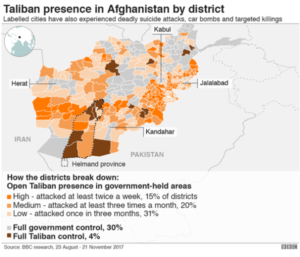
The numbers are staggering, especially considering the amount of time as well as human and financial resources the US and its allies have spent in the country. How is it that after all these years, the US has been unable to defeat an enemy that merely controls 4% of the country?
Sadly, Trump’s antics and murky policies on Afghanistan suggest that he is in a similar flux as that of his predecessors. Where George W Bush and Barack Obama repeatedly ‘claimed’ that a victory in Afghanistan was near, Trump’s military advisers have been making similar promises if provided with the right tools and resources. However, previous instances suggest that Trump’s new Afghan policy and increasing the number of troops – coupled with bringing India into the equation – would do little to improve the security situation of the country. Even seasoned American experts and journalists now believe that Washington has no idea of what it is doing in Afghanistan.
If that indeed is the case, it is the Afghan people who are bound to suffer further. Hence, it is now upon regional stakeholders to assist with establishing peace in Afghanistan, or else, further space provided to the Taliban, IS, and other militant groups could have spillover effects on immediate neighbours of Afghanistan.
The author Farooq Yousaf is a PhD (Politics) Candidate currently pursuing his studies in Australia. He has previously completed his Masters in Public Policy and Conflict Studies from Germany. He also consults Islamabad-based Security think tank, Center for Research and Security Studies (CRSS), and occasionally writes for various news and media sources. He is specialising in Indigenous conflict resolution and counter insurgency. He tweets at @faruqyusaf




